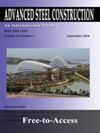钛耦合钢板的隔离腐蚀
IF 1.7
3区 工程技术
Q3 CONSTRUCTION & BUILDING TECHNOLOGY
引用次数: 8
摘要
美国超过26%的桥梁存在结构缺陷或功能过时。用于桥梁和建筑物等结构的钢的腐蚀问题已引起越来越多的兴趣和关注。由于易于获得,可接受的机械性能和成本效益的协同作用,钢通常是在此类应用中使用的首选金属。多年来,钛的强度、高度和重要性不断提高,被认为是一种比钢更强、更轻的新兴高性能金属。钛及其合金的一个独特特性是它的无腐蚀性。然而,选择和使用纯钛或其合金的一个主要缺点是成本过高。因此,将钢和纯钛和/或其合金结合在结构中是可能的,方法是限制钢用于结构的大部分,并有选择地将钛及其合金用于关键但体积小的元件,如扣板和轴承。混合使用钛与钢的结构成员将带来更好的性能,同时证明既具有成本效益,又经济实惠。结构钢和钛的协同使用会导致钛附近的钢的腐蚀加速。介绍了钛板与钢构件耦合的腐蚀性能。讨论了减小钢与钛之间电偶效应的几种可行策略。通过腐蚀实验测量钛与钢形成电偶时的腐蚀严重程度,并以铜与钢为比较体系。研究表明,当钛扣板与结构钢构件耦合时,需要采取适当的预防措施,以尽量减少局部腐蚀。本文章由计算机程序翻译,如有差异,请以英文原文为准。
Isolating Corrosion of Steel Plates Coupled with Titanium
Over twenty six percent of the bridges in the United States are structurally deficient or functionally obsolete. Corrosion of steel used in structures like bridges and buildings is a problem that has gained increased interest and focused concern. Steel is often the metal that is preferred for use in such applications due to a synergism of ease of availability, acceptable mechanical properties and cost effectiveness. Through the years, titanium has grown in strength, stature and significance to be recognized as an emerging high performance metal that is both stronger and lighter than steel. A distinctive property of titanium and its alloys is its non-corrosive nature. However, a major drawback in the selection and use of pure titanium or its alloy counterpart is the prohibitively high cost. Therefore, it may be possible to combine steel and pure titanium and/or its alloy in structures by restricting steel for bulk of the structure and selectively using titanium and its alloys for the critical but low volume elements, such as, gusset plates and bearings. A hybrid use of titanium in conjunction with steel for structural members will result in better performance while concurrently proving to be both cost-effective and economically affordable. The synergistic use of structural steel and titanium in close proximity with each other could result in accelerated corrosion of steel in the immediate vicinity of titanium. The corrosion performance of titanium plates coupled with steel members is presented. A few viable strategies for minimizing galvanic coupling effects between steel and titanium are discussed. Corrosion experiments were conducted to measure the severity of corrosion when titanium and steel form a galvanic couple, and copper and steel was a comparative system. The study revealed that adequate precautions are needed to minimize localized corrosion when titanium gusset plates are coupled with structural steel members.
求助全文
通过发布文献求助,成功后即可免费获取论文全文。
去求助
来源期刊

Advanced Steel Construction
CONSTRUCTION & BUILDING TECHNOLOGY-ENGINEERING, CIVIL
CiteScore
2.60
自引率
29.40%
发文量
0
审稿时长
6 months
期刊介绍:
The International Journal of Advanced Steel Construction provides a platform for the publication and rapid dissemination of original and up-to-date research and technological developments in steel construction, design and analysis. Scope of research papers published in this journal includes but is not limited to theoretical and experimental research on elements, assemblages, systems, material, design philosophy and codification, standards, fabrication, projects of innovative nature and computer techniques. The journal is specifically tailored to channel the exchange of technological know-how between researchers and practitioners. Contributions from all aspects related to the recent developments of advanced steel construction are welcome.
 求助内容:
求助内容: 应助结果提醒方式:
应助结果提醒方式:


